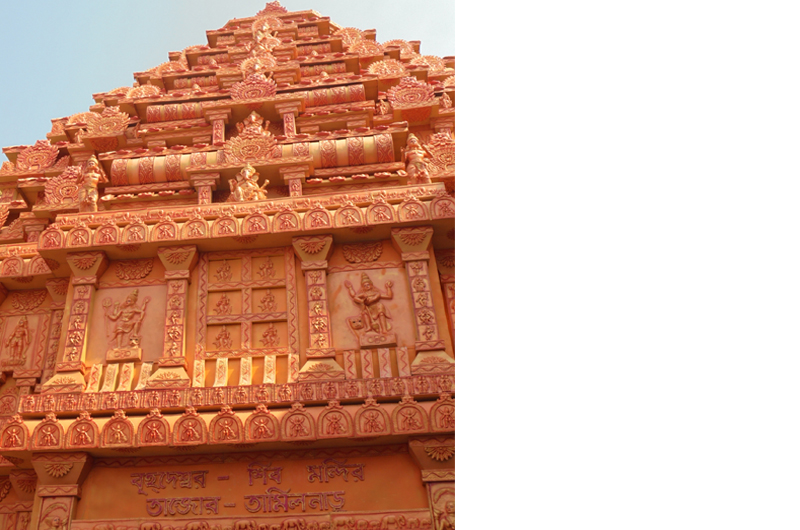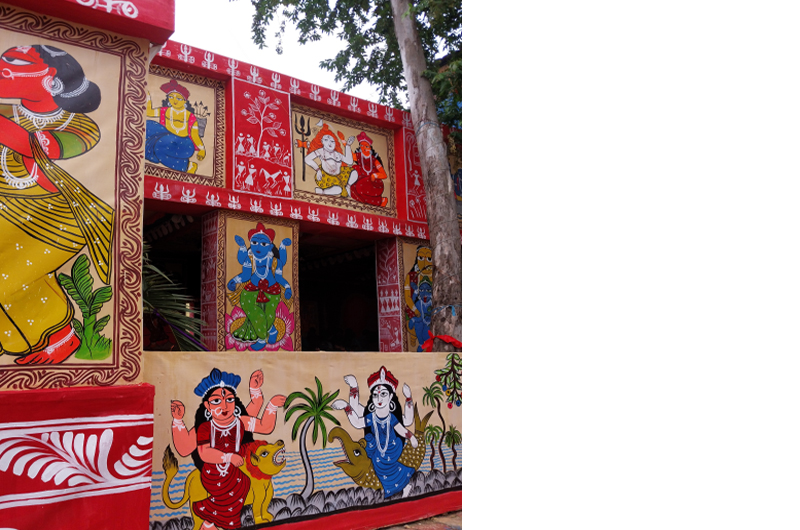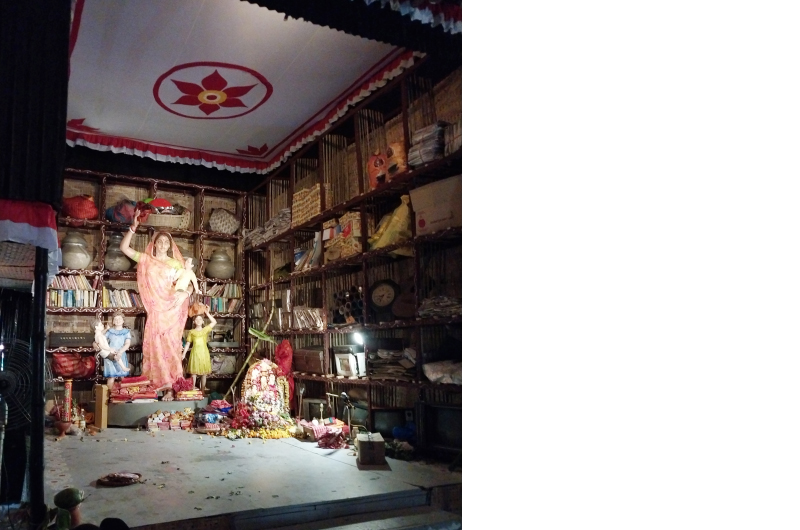Durga Puja, the biggest festival for the Bengalis, at home and even abroad these days, is now on in full swing. You can feel the excitement in the air as patches of the autumn blue sky peep from behind the monsoon clouds. Ranjita Biswas writes about how the festival has evolved through the years
In Bengal, worshipping the Shakti Goddess, slayer of evil, is not confined to only religious ritual. It encompasses many aspects, from entertainment to art to food and is a major contributor to the local economy. Taking into account its unique place in Bengal’s socio-cultural life, UNESCO recognized Durga Puja as an ‘intangible cultural heritage of humanity’ in 2022. It is interesting to observe how the festival has evolved through the years. The traditional rituals have remained but the festival has also taken on a contemporary note with the décor and ‘themes’, complete with modern sensibilities woven in.

For example, in Salt Lake, a tiny area in Kolkata, a block pujo (the planned township is divided into blocks) this year takes on the theme of environment. Joining hands with the state’s Forest Department, the theme, ‘A slice of the Sundarbans’ focuses on the vulnerable state of the world’s biggest mangrove forest area. The mangroves, natural to the delta, are a first-line barrier against the rising sea levels, saving people and property. But people, including tourists, dump waste such as plastic with any concern for the environment. The department officials reiterate that the puja pandals with thousands of footfalls is the right platform to spread the message of conservation.

A puja in the Alipore area this year has adopted the theme of how technology has taken over many aspects of human life. Social issues are the focus of many puja organizers, too. Last year, the theme in a well-known puja pandal in north Kolkata was focused on ‘the kabadiwallis’ – the women familiar to us who are on the street come rain or shine, collecting discarded goods from households for a few rupees; they also contribute to the recycling of goods. This year, the organisers of a puja have taken help of an FM radio channel to invite householders to hand over anything recyclable such as paper, old clothes, etc, which will be used to decorate its pandal.
Art and culture, of which Bengal is rightly proud of, has also got a boost thanks to the ‘theme pujas’. Today the Durga idol is not necessarily the typical murti (idol) fashioned at Kumartuli, the hub of idol-making. One witnesses a burst of creativity which helps craftsmen, visualisers and decorators alike. Artisans are often hired from the villages, even farmers whose work is over after the sowing season; they move to the city to give shape to the artist’s imagination. Rural folk artisans turn out astonishing art work, guided by the chief artist’s visualization. Many such artisans are art college alumni, sculptors and architects. In the process, many traditional crafts have seen a revival. Sometimes an edifice can look like a Tanjore temple, or an iconic symbol from South East Asia. And so, many traditional crafts have seen a revival be it shola-pith (the Indian cork that grows in water bodies) art or pata-chitra paintings.

Then there are some big puja oraganisers who lean towards glitzy subjects, like recreating Disneyland in one such this year, or the set of a film which has become a hit, ‘Bahubali’ sometime back, for instance. Sometimes, even gory details of a train accident may be depicted to attract crowds. You could wonder at their relevance to a traditional puja decoration, but you have to admire the workmanship with the minutest eye to the details.
To the uninitiated, the emphasis on a ‘theme’ since the past few decades in designing idols and pandals, started in the mid-1990s when a prominent paint company started awarding puja committees for showcasing traditional art and craft as against the frivolous attempts at creativity witnessed during the ‘disco’ age of the 1980s. Today, almost every commercial company worth its name has jumped on the wagon to award pujas in category – best theme, best lighting, best green puja, etc. Naturally, the prestige of getting an award has inspired organisers to search for special themes. The trend has percolated to the district towns all across Bengal and even to big pujas in other parts of India.
Years ago, the four-day festival was organised by zamindars and the rich, but it later opened up to the hoi polloi with the moniker barowari when twelve (baro) friends first organised it with donations from the public, making it a community puja. Today big community puja venues attract lakhs of visitors. In fact, ‘pandal hopping’ to appreciate the thakur (idol) and decorations go on through the night. The wonderful lighting decoration is another attraction at night. The other notable thing about Durga puja is that people of every class, caste and creed take part, making it truly a people’s festival. In fact, the beautiful jewellery decorations to adorn the devi are mostly made by Muslim artisans. There are instances of puja decorations that Hindus and Muslims put up together.
No wonder that the atmosphere is electric with excitement during the festival. The throbbing beat of the dhak drum, the chanting of mantras to evoke the goddess, food stalls at every corner and revelry make people forget their daily worries for the time being. Many NRIs make it point to visit home during this time to soak in the atmosphere. Another cultural tradition is to bring out special magazine editions by well-known publication houses. The writers are commissioned way ahead to meet the deadline. Here, too, avid readers compare which issue has the best to offer in articles, short stories and novels. These days, housing complexes which organise their own pujas bring out souvenirs, giving scope to hidden literary talents and there are competitions and awards in this field too.

From the 1960s, regarded as the golden age of modern Bengali songs, releasing special puja numbers was almost de rigueur for big artists. The tradition continues even in today’s digital age. All the well-known Bengali TV channels plan special programmes with artists participating in addas (gossip sessions). Cultural functions in the evenings are also a part of the puja celebrations. Famous singers and performers are booked months ahead. In community pujas in blocks and multiplexes, members host plays and musical soirees for which they rehearse for weeks.
The puja season actually starts one week ahead on the day of Mahalaya, when the devi is supposed to descend from the heavenly abode of Kailash. On Mahalaya, a tradition is to listen at dawn to the All India Radio programme Mahishasuramarddini that has been broadcasting since 1931 with the redoubtable late Birendra Krishna Bhadra reading the chandi-paath in impeccable Sanskrit ushering in the goddess to earth. Many famous singers added to the sombre mood with their devotional songs.
Food, of course, plays a major part in the celebration for the gourmand Bengalis. Long queues in front of restaurants are to be expected. Some famous sweetmeat makers launch innovative concoctions for the ‘sweet-toothed’ Bengalis. Community pujas and those held by residents in multiplexes organise community lunch called bhog for all the three days. From the traditional to the contemporary, Ma Durga has taken it all, spreading her sphere to all directions like her ten hands, to bless her worshippers with joy and fervour.
(The writer is a senior journalist who lives in Kolkata.)



 from Webdoux
from Webdoux